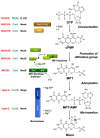The History of the Molybdenum Cofactor-A Personal View
- PMID: 35956883
- PMCID: PMC9370521
- DOI: 10.3390/molecules27154934
The History of the Molybdenum Cofactor-A Personal View
Abstract
The transition element molybdenum (Mo) is an essential micronutrient for plants, animals, and microorganisms, where it forms part of the active center of Mo enzymes. To gain biological activity in the cell, Mo has to be complexed by a pterin scaffold to form the molybdenum cofactor (Moco). Mo enzymes and Moco are found in all kingdoms of life, where they perform vital transformations in the metabolism of nitrogen, sulfur, and carbon compounds. In this review, I recall the history of Moco in a personal view, starting with the genetics of Moco in the 1960s and 1970s, followed by Moco biochemistry and the description of its chemical structure in the 1980s. When I review the elucidation of Moco biosynthesis in the 1990s and the early 2000s, I do it mainly for eukaryotes, as I worked with plants, human cells, and filamentous fungi. Finally, I briefly touch upon human Moco deficiency and whether there is life without Moco.
Keywords: gephyrin; molybdenum; molybdenum cofactor biosynthesis; molybdopterin; nitrate reductase.
Conflict of interest statement
The author declares no conflict of interest.
Figures





Similar articles
-
The Final Step in Molybdenum Cofactor Biosynthesis-A Historical View.Molecules. 2024 Sep 20;29(18):4458. doi: 10.3390/molecules29184458. Molecules. 2024. PMID: 39339452 Free PMC article. Review.
-
Function of Molybdenum Insertases.Molecules. 2022 Aug 23;27(17):5372. doi: 10.3390/molecules27175372. Molecules. 2022. PMID: 36080140 Free PMC article. Review.
-
The molybdenum cofactor.J Biol Chem. 2013 May 10;288(19):13165-72. doi: 10.1074/jbc.R113.455311. Epub 2013 Mar 28. J Biol Chem. 2013. PMID: 23539623 Free PMC article. Review.
-
Cell biology of molybdenum in plants and humans.Biochim Biophys Acta. 2012 Sep;1823(9):1568-79. doi: 10.1016/j.bbamcr.2012.02.007. Epub 2012 Feb 17. Biochim Biophys Acta. 2012. PMID: 22370186 Review.
-
The biosynthesis of the molybdenum cofactors in Escherichia coli.Environ Microbiol. 2020 Jun;22(6):2007-2026. doi: 10.1111/1462-2920.15003. Epub 2020 Apr 6. Environ Microbiol. 2020. PMID: 32239579 Review.
Cited by
-
Molybdenum facilitates PDLSC-based bone regeneration through the JAK/STAT3 signaling pathway.Sci Rep. 2025 Jul 1;15(1):22204. doi: 10.1038/s41598-025-07298-7. Sci Rep. 2025. PMID: 40594624 Free PMC article.
-
Advancing Our Understanding of Pyranopterin-Dithiolene Contributions to Moco Enzyme Catalysis.Molecules. 2023 Nov 7;28(22):7456. doi: 10.3390/molecules28227456. Molecules. 2023. PMID: 38005178 Free PMC article. Review.
-
Chlamydomonas reinhardtii-A Reference Microorganism for Eukaryotic Molybdenum Metabolism.Microorganisms. 2023 Jun 27;11(7):1671. doi: 10.3390/microorganisms11071671. Microorganisms. 2023. PMID: 37512844 Free PMC article. Review.
-
Advances in actinobacteria-based bioremediation: mechanistic insights, genetic regulation, and emerging technologies.Biodegradation. 2025 Mar 14;36(2):24. doi: 10.1007/s10532-025-10118-4. Biodegradation. 2025. PMID: 40085365 Review.
-
Moco Carrier and Binding Proteins.Molecules. 2022 Oct 4;27(19):6571. doi: 10.3390/molecules27196571. Molecules. 2022. PMID: 36235107 Free PMC article. Review.
References
-
- Pau R.N., Lawson D.M. Transport, homeostasis, regulation, and binding of molybdate and tungstate to proteins. Met. Ions Biol. Syst. 2002;39:31–74. - PubMed
Publication types
MeSH terms
Substances
Grants and funding
LinkOut - more resources
Full Text Sources

